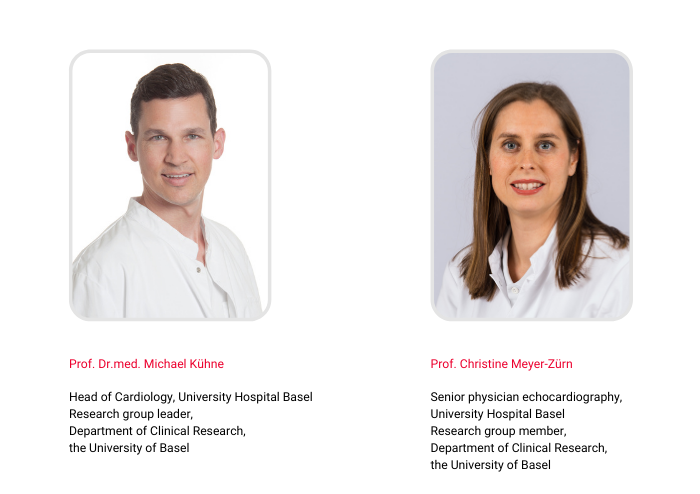An interview with Prof. Michael Kühne and Prof. Christine Meyer-Zürn – The SWISS-AF-Burden study leaders from the University of Basel.
The SWISS-AF-Burden study is underway at the University Hospital Basel, in which the impact of atrial fibrillation burden on incidents such as stroke, heart failure and dementia is being investigated. Broader knowledge about patients with AF could help to tailor medical treatment to the individual characteristics of each patient in the future. In order to optimize the research process, the University Hospital Basel invited Cardiomatics to cooperate with them.
Atrial fibrillation is known as a new “epidemic” in cardiology. Why?
MK: Atrial fibrillation (AF) is the most common sustained cardiac arrhythmia in clinical practice and its prevalence is increasing dramatically. At age 45, the lifetime risk for developing AF is over 20% and increases to 38% if at least one cardiovascular risk factor is present.
What can explain such a rapid increase in the appearance of atrial fibrillation?
CMZ: The rapid increase in AF can be attributed to the advanced age of people in the industrialized nations and the increasing prevalence of cardiovascular risk factors such as hypertension, diabetes and obesity.
What makes atrial fibrillation such a dangerous disease?
CMZ: Atrial fibrillation is strongly associated with the risk of adverse cardiovascular events, such as stroke, heart failure and death, as well as with cognitive dysfunction and a reduced quality of life.
Prof. Michael Kühne, for the last 20 years, you have been professionally involved in the treatment of atrial fibrillation. How has the treatment approach for this condition changed? How has the diagnosis of atrial fibrillation changed during this time?
MK: Within the last 20 years, we have learned a lot about the best medical and interventional approaches to treat AF. The introduction of non-vitamin K dependent oral anticoagulants (NOAC) has helped to overcome the limitations of traditional anticoagulation by vitamin K antagonists (e.g., a narrow therapeutic interval, necessitating frequent monitoring and dose adjustments), and NOAC are at least as effective as vitamin K antagonists for stroke prevention, but safer with regard to bleeding. With regard to AF ablation, the chances of success of pulmonary vein isolation have been markedly improved, with a decrease in complication rates. In addition, an integrated AF treatment approach has been introduced with a focus on comorbidities. In recent years, more and more patients have been using their smartphone, smartwatch or other wearable devices to screen for AF.
What is the treatment of atrial fibrillation currently based on? Has it changed as a result of the publication of the latest guidelines of the European Society of Cardiology?
CMZ: Treatment of AF is based on rate and rhythm control strategies. According to the latest guidelines of the European Society of Cardiology published in summer 2020, the management of AF patients should be based on the Atrial fibrillation Better Care (ABC) holistic pathway, which provides integrated care of AF patients across all healthcare levels. In this pathway, „A” stands for Anticoagulation/Avoid stroke, „B” for Better symptom management and „C” for Cardiovascular and Comorbidity optimization. 2020 was also an important year for AF treatment because of the publication of the EAST-AFNET 4 trial, which showed that treating AF early in the course of the disease is associated with better outcomes.
According to the current guidelines, the diagnosis of atrial fibrillation obliges doctors to assess the risk of thromboembolism and, if necessary, initiate anticoagulation therapy. How do you rate the application of the current guidelines by doctors?
MK: The CHA2DS2-VASc score is an easy tool that is routinely applied by physicians and that gives a clear recommendation for or against oral anticoagulation therapy. However, physicians should be careful not to use reduced-dose NOAC if not clearly indicated. In the future, we hope to be able to predict stroke risk much better using combined scores (e.g., incorporating AF burden and biomarkers) in order to further personalize therapy.
What questions are researchers facing in the Swiss-AF-Burden project?
CMZ: In order to adequately allocate health care resources, a better understanding of AF burden and whether it contributes to outcomes are sorely needed. In the Swiss-AF Burden project, we aim to increase our knowledge on the association between AF burden, defined as the percentage of time in AF, and its health consequences, which are mainly stroke/systemic embolism and cognitive dysfunction.
What methodology is being used to conduct the study?
MK: Patients from the SNSF funded Swiss-AF cohort study, an observational multi-center study including 2,415 patients from 14 sites across Switzerland, are included in the Swiss-AF Burden study if they suffer from paroxysmal or persistent AF. In these patients, AF burden is to be measured twice, 1 year apart and correlated to outcome events. Furthermore, information on cardiac structure and function is being assessed using cardiac MRI. A subset of patients have undergone implantation of a loop recorder to continuously measure AF burden throughout the study.
Why did you decide to use Cardiomatics AI-based tool for ECG signal analysis? How does this affect the work of your team?
CMZ: Within Swiss-AF Burden, we measure the AF burden manually from a standard 7-day Holter ECG. The medical-grade system which we are using ensures high-quality and trusted outcomes based on accurate algorithms. This helps us to independently validate our results, especially in patients with multiple AF episodes and noisy recordings, where the manual estimation of the AF burden can be challenging.
How does this change your daily routine regarding work with cloud AI-based digital analyses from Cardiomatics?
MK: The web-based platform is very simple and user-friendly. After uploading the raw signal of the ECG, we get access to a detailed report within a few hours. In a clinical routine, this can save a lot of time compared to the time-consuming analysis of Holter recordings with conventional Holter software.
Can you share your preliminary results based on the collected data?
CMZ: Currently, we are still including patients and working hard on the ECG signals. We are convinced that we can present the first results of our work soon.
How could the final results of the Swiss-AF-Burden study potentially influence the current recommendations for the treatment of atrial fibrillation?
MK: Swiss-AF Burden will provide novel and unique insights into the association between directly measured AF burden and its health consequences, namely stroke. If we can prove that the AF burden has a significant impact on the measured endpoints, the results would recommend specifically using AF burden to determine risk and including the parameter in risk scores and calculators for stroke prediction and potentially for decision making tools regarding oral anticoagulation.
You are the leader of a research group at the University of Basel in which you research the most common arrhythmias. What additional aspects of AF are you working on?
MK: In addition to the Swiss-AF Burden study, we are currently assessing the association between silent brain lesions and cognitive decline in AF patients, which also have a major impact on our health care systems. Within the SNSF-funded Swiss-AF Brain project, we aim to discover the mechanisms underlying cognitive decline in these patients by performing advanced brain MRI. To explore the causal role of AF in the development of brain lesions and cognitive deficits, we have initiated a control group of patients in sinus rhythm (SNSF-funded Swiss-AF Control study), who will be followed and compared to the AF patients included in the Swiss-AF Cohort.
What other areas related to the diagnosis and treatment of atrial fibrillation require urgent investigation?
CMZ: Most recently, new techniques for digital ECG analysis (e.g., machine learning and artificial intelligence) and new technologies to screen and diagnose AF (e.g., wearable devices) have been introduced. These innovations offer us new ways to personalize the treatment of AF and to improve risk stratification in the individual patient. However, studies that assess these opportunities in detail and trials that define which groups of AF patients benefit most are still lacking. With regard to AF treatment, gaps in current knowledge include the role of biomarkers in AF treatment, the use of oral anticoagulation in specific AF patients (e.g., after heart valve therapy, after bleeding or stroke) and various other questions around catheter ablation (e.g., ablation technique, value in preventing AF progression).
How do you think the COVID-19 pandemic has affected the diagnosis of atrial fibrillation?
MK: During the first peak of the pandemic in spring 2020, the fear of COVID-19 kept many patients away from hospitals, and presumably, patients with AF-related symptoms who had not yet been diagnosed with AF as well. Potentially life-saving therapies, such as oral anticoagulation and rate and rhythm control therapies, were not implemented in these patients.
Can the determination of the atrial fibrillation load be important for the further management of patients, in particular those who do not experience its symptoms and without other medical burdens?
CMZ: In the Swiss-AF study, we will learn a lot about the direct relationship between the AF burden and adverse cardiovascular events. This will help to further define the threshold of AF burden at which oral anticoagulation therapy should be initiated, including in low-risk patients with a very high burden of AF and those with a low burden who are high-risk.
Thank you for your time!


